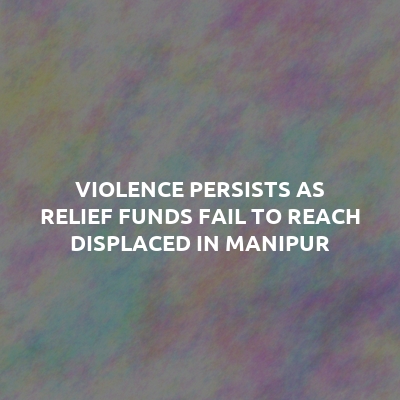IT News
Imphal, April 13:
Despite the Central government’s release of Rs 217 crore for relief and rehabilitation of Internally Displaced Persons (IDPs) in Manipur, ground reports reveal that many of the affected continue to live in dire conditions, with little to no access to government support. A reliable source has informed Imphal Times that the failure of these funds to reach the displaced is contributing significantly to the ongoing unrest in the state.
“Many of the displaced are still taking shelter along highways in Kangpokpi district, surviving without basic facilities. The government’s financial aid may have been sanctioned and released, but it has not reached the intended beneficiaries,” the source said. He further added that the frustration over this neglect was one of the triggers behind the March 8, 2025 violence, pointing to rising anger among IDPs who feel abandoned.
When asked about the prefabricated houses that were inaugurated by Manipur Minister Nemcha Kipgen, the source admitted that while some houses were indeed constructed and distributed, they only reached a fraction of those in need. “Only around 20% of the displaced families received any benefit. The rest continue to live in harsh, unsafe conditions,” the source claimed.
This alarming situation stands in sharp contrast to official data, which shows substantial financial support pouring into Manipur. According to government officials, the Union Ministry of Home Affairs allocated Rs 217 crore during the 2024–25 fiscal year specifically for relief and rehabilitation of those displaced by the ethnic violence that began on May 3, 2023.
Over 50,000 individuals — men, women, and children — remain housed in approximately 250 relief camps spread across several districts, nearly two years after the violence first erupted. While the government claims to have constructed thousands of prefabricated homes, the effectiveness and reach of this initiative remain under serious question.
A senior official in the Manipur Finance Department highlighted that the state received an unprecedented Rs 1,926 crore in March 2025 alone from the Centre under various schemes. This includes Rs 1,437 crore under the Scheme for Special Assistance to States for Capital Investment (SASCI), with Rs 869 crore of that arriving in March. The SASCI allocation also included Rs 320 crore specifically for clearing liabilities related to PWD works.
Additional funds included Rs 169 crore under PMAY-Grameen for rural housing, Rs 520 crore for school education, Rs 305 crore for health, and Rs 458 crore from the Ministry of Women and Child Development. Notably, an extra (fifth) instalment was received under the National Health Mission — a rare move beyond the usual four.
Yet, despite this massive influx of funds, the state’s relief implementation on the ground appears to have glaring gaps. With Manipur under President’s Rule since February 13, the Union Finance Minister presented the state’s 2025–26 budget in Parliament, proposing a total expenditure of Rs 35,104 crore. However, unless transparency and accountability in fund distribution are ensured, the budgetary promises risk being reduced to numbers on paper, offering no real relief to those who need it most.
The growing disconnect between the Centre’s aid announcements and the realities faced by the displaced communities raises serious concerns about governance, oversight, and the political will to address a crisis that shows no sign of abating.



